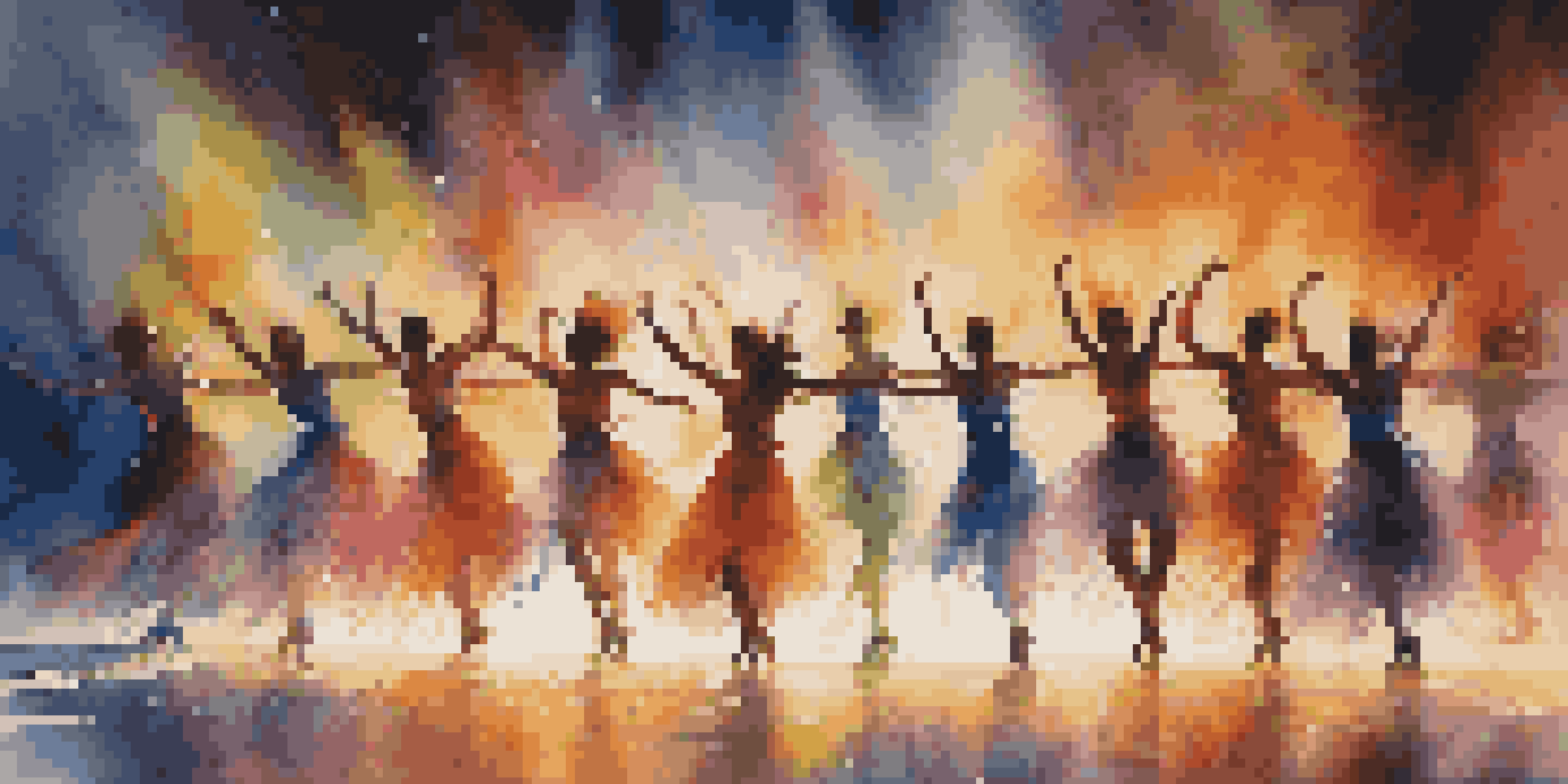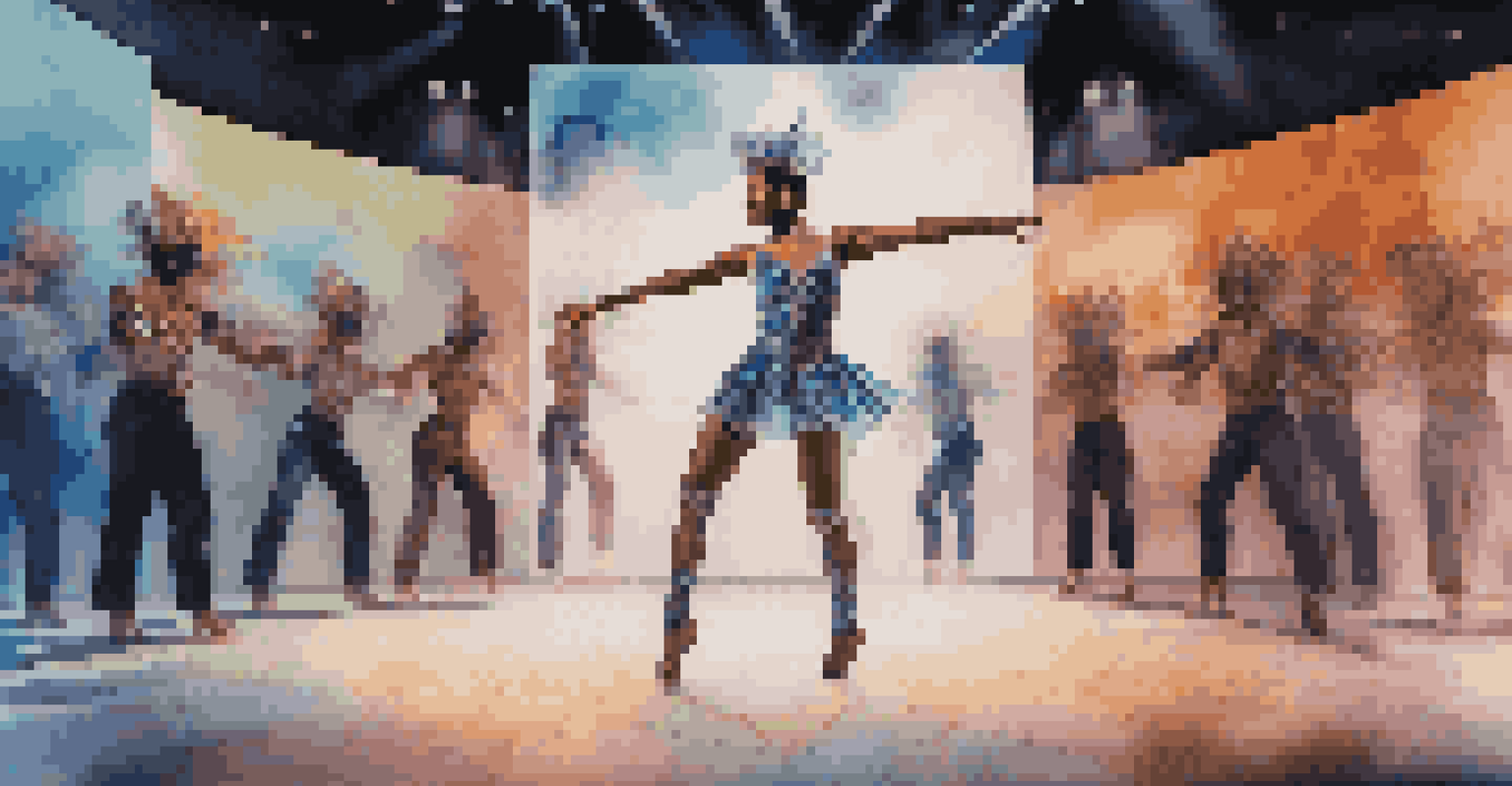Emerging Technologies in Dance Costume Design: A Review

The Intersection of Dance and Technology: A New Era
In recent years, the world of dance has seen a remarkable convergence with technology, leading to innovative costume designs that enhance performance. Dancers are no longer restricted to traditional fabrics and styles; instead, they are embracing materials that incorporate technology for both aesthetic and functional purposes. This shift not only captivates audiences but also allows dancers to express their artistry in new and exciting ways.
Technology is best when it brings people together.
For instance, the use of LED lights in costumes has transformed the visual aspect of performances. Imagine a dark stage illuminated by dancers adorned in glowing outfits, creating a mesmerizing visual spectacle. These costumes often integrate programmable lights that can change color or pattern, allowing for synchronization with music and choreography, thus enriching the storytelling element of dance.
Furthermore, the integration of smart textiles is revolutionizing how costumes are designed. These fabrics can monitor a dancer's movements and even respond to their body temperature, offering insights into performance and comfort levels. As technology continues to evolve, the potential for creating dynamic costumes that adapt in real-time opens up endless possibilities for choreographers and performers alike.
3D Printing: Revolutionizing Costume Creation
3D printing has emerged as a game-changer in costume design, allowing designers to create intricate pieces that were previously unimaginable. This technology enables the precise layering of materials, resulting in unique textures and forms that can be tailored to the specific needs of a performance. The ability to rapidly prototype costumes also means that designers can experiment with new ideas without the traditional costs and time constraints.

For example, a designer might create a complex headpiece or accessory that not only complements the choreography but also enhances the narrative of the performance. By printing these elements, they can achieve a level of detail that would be difficult to replicate with conventional methods. This not only heightens the visual appeal but also adds a sense of innovation to the dance itself.
Tech-Enhanced Dance Costumes
The integration of technology in dance costumes, like LED lights and smart textiles, allows for innovative performances that captivate audiences.
Moreover, 3D printing supports sustainable practices in costume design. By using biodegradable materials and minimizing waste during production, designers can create stunning costumes while being mindful of their environmental impact. This aspect of technology aligns well with the growing emphasis on sustainability in the arts, making it a win-win for both creators and the planet.
Wearable Technology: Enhancing Performance and Interaction
Wearable technology is another exciting development in dance costume design, pushing the boundaries of what costumes can do. Devices such as motion sensors and fitness trackers can be seamlessly integrated into costumes, providing real-time feedback on a dancer's movements. This data not only helps dancers improve their technique but also allows choreographers to analyze performances in new ways.
Innovation distinguishes between a leader and a follower.
Imagine a costume that tracks a dancer's heart rate, movement speed, and even muscle fatigue, all while they perform. This information can inform training regimens and performance adjustments, ultimately leading to better overall health and artistry. Furthermore, this technology can be used to foster collaboration between dancers and choreographers, as they can review data together to enhance future performances.
Additionally, wearable tech can create interactive experiences for the audience. Costumes that respond to sound or light can transform a live performance into a multi-sensory experience, blurring the lines between performer and viewer. This level of engagement not only captivates audiences but also invites them to become part of the artistic expression.
Augmented Reality: Blending Virtual and Reality in Costumes
Augmented reality (AR) is making waves in the world of dance by merging the physical and digital realms. With AR technology, dancers can wear costumes that are enhanced with digital overlays, creating a visual spectacle that is both immersive and interactive. This allows for a new layer of storytelling, where elements of the performance can be enhanced through digital effects visible to the audience through their devices.
For instance, a dancer might wear a costume that appears to change patterns or colors when viewed through an AR app. This not only adds an exciting visual element but also allows for creativity that transcends the limitations of physical materials. Performances can become experiences that engage audiences on multiple levels, inviting them to participate through their smartphones or tablets.
Sustainability in Costume Design
A growing focus on sustainable materials and practices in costume design is reshaping the industry and fostering environmental responsibility among creators.
As AR technology continues to develop, its applications in dance are likely to expand. The possibilities for collaboration between dancers, costume designers, and tech developers are vast, leading to innovative performances that challenge traditional perceptions of dance. This intersection of art and technology opens up new avenues for expression and engagement.
Sustainable Materials: Eco-Friendly Innovations in Costumes
The push for sustainability in the arts has led to a significant shift in costume design, with many designers seeking eco-friendly materials. Innovations such as organic cotton, bamboo fabric, and recycled polyester are becoming increasingly popular in dance costumes. These materials not only reduce environmental impact but also offer unique textures and properties that can enhance performance.
Designers are now focusing on how to create costumes that are both visually striking and sustainable. For example, a costume made from recycled plastic bottles not only tells a story of transformation but also raises awareness about waste in our environment. This approach resonates with audiences who are increasingly concerned about sustainability, creating a deeper connection between the performer and the viewer.
Moreover, sustainable practices extend beyond materials to include the entire design process. Designers are adopting techniques that minimize waste and promote recycling, such as upcycling old costumes into new designs. This holistic approach not only fosters creativity but also encourages a culture of responsibility within the dance community, highlighting the importance of environmental stewardship.
Digital Fabrication: Customization at Your Fingertips
Digital fabrication technologies, such as laser cutting and CNC machining, are transforming the way dance costumes are created. These methods allow for precision and customization that traditional sewing techniques simply cannot match. Designers can create intricate patterns and shapes that fit perfectly to a dancer's body, enhancing both comfort and aesthetics.
For example, a costume designed with laser-cut patterns can incorporate ventilation or flexibility in ways that enhance movement. This level of detail not only improves the dancer's performance but also adds an artistic flair to the costume itself. As a result, each piece becomes a unique representation of the dancer's individuality and the choreographer's vision.
Future of Dance Costumes
Emerging technologies such as 3D printing and augmented reality are set to revolutionize dance costumes, enabling more creativity and interactivity in performances.
Additionally, digital fabrication enables designers to collaborate more effectively with dancers. By using 3D modeling software, they can visualize how a costume will move and fit before it's even made. This collaborative process ensures that the final product is not only beautiful but also functional, meeting the specific needs of each performance.
The Future of Dance Costumes: Trends and Predictions
As we look towards the future, the landscape of dance costume design is likely to continue evolving with technology. Emerging trends such as virtual reality experiences and AI-generated designs hold exciting potential for the dance world. These advancements could allow for even more dynamic and interactive performances that redefine the audience's experience.
Moreover, as technology becomes more accessible, we may see a rise in independent designers utilizing these tools to create innovative costumes. This democratization of design technology can lead to a richer diversity of styles and ideas within the dance community, fostering a culture of experimentation and collaboration.

Ultimately, the fusion of dance and technology presents a unique opportunity for artists to explore new forms of expression. As they continue to push the boundaries of costume design, we can expect to see performances that not only entertain but also inspire and provoke thought about the role of technology in our lives.